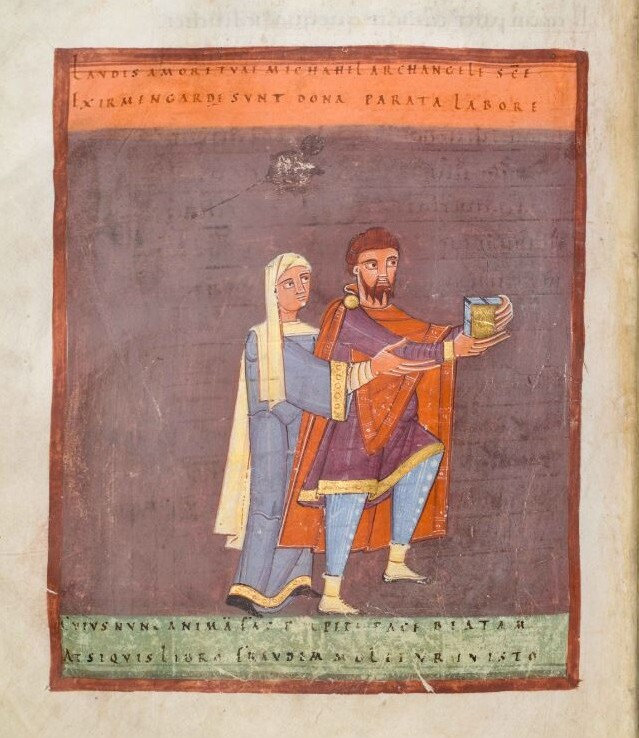Getty Adds Early Medieval Manuscript and Annibale Carracci Painting
Irmengard and Her Husband Werner, shortly after 1053. Tempera colors, gold, and ink. Image courtesy of Dr. Guenther Rare Books AG, Basel. Getty Museum, 2023.6.253v
LOS ANGELES, CA.- The Getty Museum announced today two major acquisitions: the Irmengard Codex, a manuscript made for the eleventh-century noblewoman Irmengard of Nellenburg, a member of the House of Egisheim-Dagsburg in Germany; and Madonna and Child with Saint Lucy, Saint Dominic, and Saint Louis of France by the renowned and influential Italian painter Annibale Carracci.
“These two exquisite acquisitions add key works to our representation of northern European medieval manuscript illumination and to our already strong holdings of seventeenth-century paintings,” says Timothy Potts, Maria Hummer-Tuttle and Robert Tuttle Director of the Getty Museum. “The Irmengard Codex, with its unusually rich body of imagery, is a spectacular example of early medieval manuscript illumination, the likes of which has not appeared on the market in over half a century. And together with Caravaggio, Annibale was one of the prime instigators of the baroque movement in Italian art.”
Irmengard Codex
The Irmengard Codex was created in Germany in the mid-11th century. A collection of readings for the Mass, the manuscript contains 15 full-page illuminations executed in the otherworldly pinks, blues, and lavenders that characterize painting of the so-called long Ottonian era. The Ottonian Empire took its name from three consecutive emperors named Otto, who ruled in the 10th and early 11th centuries, but the cultural age continued into the reign of the Salian emperors, who ruled Germanic lands from 1024 to 1125. Irmengard of Nellenburg, the codex’s patron, was a member of a powerful local ruling family, the House of Egisheim-Dagsburg. She was related to Pope Leo IX (1002-1054) and was the Ottonian Emperor Henry II's niece (973-1024).
Based on the script, it is thought that the text of the Irmengard Codex was written around 1030-1050. The full-page miniatures were added shortly after 1053 at the order of Irmengard. The illumination program culminates in an extremely rare dedication image in which Irmengard presents her book in memory of her deceased husband Werner and their son Adalbert, who were killed in 1053 at the Battle of Civitate. The starkly beautiful illuminations include portraits of the four evangelists and images that highlight the most important feasts of the Christian calendar. Illuminations such as the Annunciation and the Three Marys at the Tomb are conceived as double-page spreads, with the scene spanning across both pages to form a single composition. This dramatic narrative device was also utilized in the final two-page spread featuring Irmengard and her husband offering the book itself to Christ and Saint Michael.
“The Irmengard Codex represents the preeminent center of German illumination of the period, the Reichenau school, in which the powerful and theatrical figures underscore the stateliness of events they enact,” says Elizabeth Morrison, senior curator of manuscripts at the Getty Museum. “We have been unable to add any object from this remote era to the collection since the 1980s, so it is impossible to overstate the historic rarity of this acquisition.”
The manuscript will be showcased in an upcoming exhibition in Fall 2023.
The Angel at the Empty Tomb of Christ, shortly after 1053. Tempera colors, gold, and ink. Image courtesy of Dr. Guenther Rare Books AG, Basel. Getty Museum, 2023.6.118
Annibale Carracci Painting
In this small-scale painting on copper, Annibale created a composition that is both intimate and monumental. The Virgin sits on the left, wrapped in the traditional blue mantle and red dress. The Christ child sits precariously on a silk pillow placed on his mother’s lap. Saint Lucy kneels before the Virgin and Child in a red dress with a yellow cloak and a white veil covering her head. From behind, two other saints, Saint Louis of France and Saint Dominic, watch the scene in devotion. The scene is painted in warm golden sunlight and opens into a landscaped background.
In the painting, the Virgin exhibits the grace and nobility of Madonnas painted by Raphael, while the warm light pervading the scene recalls that of Correggio, the two Italian artists Annibale revered most. The painting also represents Annibale at the peak of his artistic maturity, when he moved to Rome in 1595 to paint frescos in the Palazzo Farnese, works that would greatly influence the course of seventeenth-century art.
Annibale has a limited body of work due partly to his relatively short life (1560-1609) and the fact that his major works are still in situ in Italian churches and palaces. Even so, he is considered one of the founding fathers of Italian Baroque painting. Although Annibale could depict everyday scenes with remarkable truth, his visual world remained firmly idealized based on classical concepts of harmony and balance, which contrasted with the more radical vision of his contemporary and rival Caravaggio.
“Annibale Carracci is one of the creators of the visual language of the Baroque with its emphasis on gestures and emotion,” says Davide Gasparotto, senior curator of paintings at the Getty Museum. “He executed a handful of paintings on copper destined for exacting patrons. This painting, although small in scale, is quite ambitious in terms of composition and perfectly encapsulates the style Annibale developed after he moved to Rome from Bologna in 1595.”
The acquisition expands a group of other paintings on copper in the collection including The Way to Calvary by Domenichino and The Shade of Samuel Invoked by Saul by the Neapolitan Bernardo Cavalino. The painting also compliments a small selection of works on paper by Annibale and his brother Agostino Carracci in the Museum’s drawings collection.
The painting will go on display at the Getty Center in April 2023 in Gallery N205.
Virgin and Child with St. Lucy, St. Dominic, and St. Louis of France, about 1596–1598, Annibale Carracci. Oil on copper, 17 1/8 × 13 1/4 in. Getty Museum, 2023.3.

/https%3A%2F%2Fprofilepics.canalblog.com%2Fprofilepics%2F1%2F0%2F100183.jpg)
/https%3A%2F%2Fstorage.canalblog.com%2F03%2F02%2F119589%2F96711876_o.jpg)
/https%3A%2F%2Fstorage.canalblog.com%2F11%2F31%2F119589%2F94773502_o.jpg)
/https%3A%2F%2Fstorage.canalblog.com%2F20%2F83%2F119589%2F94772815_o.jpg)
/https%3A%2F%2Fstorage.canalblog.com%2F26%2F72%2F119589%2F75604929_o.jpg)
/https%3A%2F%2Fstorage.canalblog.com%2F59%2F60%2F119589%2F26458628_o.jpg)





/http%3A%2F%2Fstorage.canalblog.com%2F68%2F17%2F119589%2F128925733_o.jpg)
/http%3A%2F%2Fstorage.canalblog.com%2F60%2F53%2F119589%2F128446261_o.jpg)
/http%3A%2F%2Fstorage.canalblog.com%2F77%2F19%2F119589%2F126247017_o.jpg)
/http%3A%2F%2Fstorage.canalblog.com%2F82%2F08%2F119589%2F122394483_o.jpg)